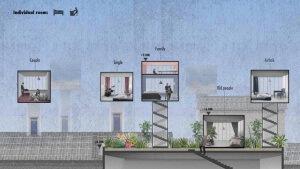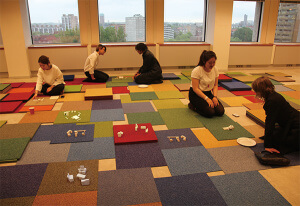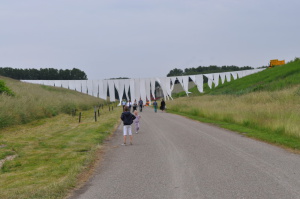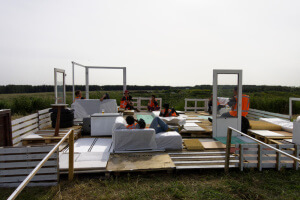INSIDE, Master in Interior Architecture at the Royal Academy of Art in The Hague
Cultural and social challenges in Interior Architecture
INSIDE is a master’s course for interior architects who start every assignment by conducting a wide-ranging exploration of a spatial context undergoing change. Wideranging here means that through observation, research and theoretical study, students chart and analyse a whole array of issues that are relevant to the spatial change that the context is undergoing. That wide range consists not only of spatial aspects but also of social, historical and ecological issues at play in the wider surroundings. After setting up and carrying out their investigation, the INSIDE students hone their skills in using the acquired knowledge to determine essential qualities that are of decisive importance for the spatial changes taking place. They then learn to incorporate those qualities in a spatial proposal grounded in a realistic perspective and in their social implications.
From inside to outside
The term INSIDE not only specifies the space in which and on which interior architects work but also indicates the mentality with which they do it. These designers engage fully with society and have a keen awareness of social, economic and technological changes. They are capable of using their position to shape the relation between the space that relates most directly to people and the world that encompasses that specific context. For an interior architect, ‘inside’ is never isolated but always connected to ‘outside’.
To emphasize the relevance of the surrounding world to interior design, INSIDE started by embracing the motto ‘Design for the Real World’. This motto references a 1971 publication by the Austrian-American product designer and tutor Victor Papanek. Some forty years ago, Papanek sketched a picture of a practice he detested, in which designers produced useless, attention-grabbing, polluting, purely commercial and even dangerous products. INSIDE feels an affiliation with the line of reasoning developed by Papanek for product designers and translated its principles to the world of spatial design within which we now find ourselves. In this way, INSIDE searches for the topicality and urgency of interior architecture in the ‘real world’, and thus for the contemporary cultural and social challenges for the interior architect.
Cultural urgency
A focus on the cultural and social challenges that face designers brought INSIDE to formulate a number of principles that determine the nature of the study course. For instance, at INSIDE we initially work on projects concerning spatial change with an explicit social relevance and, moreover, a significant cultural urgency. For instance, a student charted from a variety of perspectives the history of a mountain village in China threatened with abandonment. Drawing on her analysis, she then proposed interventions at the scale of the economic and collective places of encounter. These interventions enable the village to make better use of its resources. At the same time, a tight-knit community forms around the new collective places of encounter, reducing the necessity to relocate to big cities. By approaching the spatial and social issues in the village in an integrated manner, this student creates new collective places. In this way she succeeds in assuming the role of bridge builder between research, design and practice.
Voyage of discovery
The interior architect who graduates from INSIDE displays a sense of connection with ‘the urgencies and challenges of contemporary society’ not only in the nature of the projects he or she does but also in how he operates. This designer does not approach a spatial context in isolation, as though it were an unrelated assignment or a tabula rasa, but always tackles it in relation to existing patterns of use and current occupants, and in relation to its wider context. An extended exploration of the characteristics of the spatial context undergoing change therefore forms an integral aspect of the design process. INSIDE sees plenty of opportunities for designers who take responsibility for the society in which they live and work, a responsibility that can express itself in various ways: from the enthusiastic idealism of the designer who dreams up visionary plans for a possible sustainable world, to the socially responsible commitment of the pragmatic designer who devises solutions for current urgencies.

Graduation project Juyuan Chen, ‘Future ruralization of Longshang Village’, China 2015
The architects at SUPERUSE have been involved in the course at INSIDE from the very start. In all their work they acknowledge their responsibility for the ecological dimension of spatial interventions.
The real world
The relation with the real world is expressed in all parts of the INSIDE course and thus certainly in the choice of architects and offices that head the core studios. After all, they represent that real world and draw naturally from their practices in choosing real contexts and approaches as the basis for every studio project. Among the studio tutors at INSIDE are designers from MVRDV and OMA.

Graduation project Sisi Li, ‘Reactivate the Hutong’, 2016
By focusing on urgent themes affecting society, we highlight issues in today’s world that are also relevant to current professional discourse. As far as the intended research and results are concerned, students are encouraged to think beyond what is possible. Idealism, imagination and sense of reality must find the right balance at the Royal Academy of Fine Art, where challenging the impossible is an everyday ambition. INSIDE aims to educate interior architects as autonomous minds, working in an applied context, who succeed in deploying the built environment as material for the imagination. They are designers who explore with an organic intelligence and act on the strength of a strong sense of responsibility to improve the built environment spatially, and thus also socially.

Graduation project Sisi Li, ‘Reactivate the Hutong’, 2016
The interior space
INSIDE focuses on design with social relevance, hence we do not respect the boundaries of specific physical or programmatic areas of work but, instead, concentrate on current thematic issues such as: changes in the health care system; the rise in the ageing population; the consequences of ‘the new world of work’; vacancy of office and retail space; changing lifestyles; the industrialization of the food industry; attention for schooling and education; and increasing importance through desire and necessity of self-organization. The spatial and social impact of these issues manifests itself in all areas of work of the interior architect. And moreover, students from countries all over the world at INSIDE prove capable of putting forward relevant social issues with a spatial component and with a cultural urgency we are unfamiliar with in the Netherlands, such as the seemingly unstoppable urbanization now taking place in China. INSIDE does not educate students to work exclusively in a Dutch spatial context. By enabling students to ‘pick up’ projects in their native countries and to develop them at INSIDE for their graduation, we open the door for an exchange of international experiences and mutual cultural influencing.
Entrepreneurs and instigators
Within the nature of commissions available in interior architecture, the highlighting of social relevance and cultural urgency in design projects is not always apparent; in fact, they often recede into the background. In such cases, we educate INSIDE students to enrich existing projects with that relevance and urgency or to take the initiative in defining such assignments for themselves. The role of the interior architect as a connector and bridge builder between research, design and practice would seem to be more relevant than ever. It is a practice in which citizens have become more vocal, and no longer consist of individuals but they consist of professionally organized collectives that cause the need to approach social and spatial issues in an integrated manner and not in isolation. More than has been the case up to now, commissioning in these processes entails working together with various parties with various interests. INSIDE attaches great importance to the skill of future interior architects in being able to explore such processes and, within them, to be able to define relevant interventions. At INSIDE, entrepreneurial skills stand for the successful running of a design office as well as instigating processes at the personal initiative of the designer. For INSIDE, the interior architect of the future is someone who, when commissions for desirable or even necessary spatial changes are not forthcoming, is capable of initiating them himself.

Graduation project MinSun Kim, ‘Home for a moment’, 2013
The structure of our course
The INSIDE course is structured in a similar way to a research and design office. The main features of the course are the Studios in which students complete the entire process of a research and design project: orientation, research (through design), analysis, concept development, design (through research), presentation and evaluation. In the first year students are allotted four to eight weeks (comparable to a competition submission) or eighteen weeks (comparable to a regular commission) for the main projects in the Studios. Within the research and design process, various aspects are explored in depth in four parallel programmes: Theory, Flows, Skills and Travel. These programmes form an integral part of the design process in practice, but they are given added emphasis during the INSIDE course in relation to the Studio projects, and are supervised by specialist tutors. In this way, the analysis of the dynamic nature of a spatial context undergoing change is scrutinized closely in Flows, while the various theoretical aspects of a project are explored in Theory. An introduction to specific skills required in a project and to the approach of a particular tutor is offered in Skills, and relevant projects are visited in Travel.
In the second year a Graduation Studio is organised to assist students in drawing up individual graduation projects. Students work independently and cover the entire process of orientation, research (through design), analysis, concept development, design (through research) and presentation by themselves, under the individual supervision of the tutors.
Studio
The Studios form the backbone of the course, where students cover the entire process of orientation on the research and design of a selected spatial context undergoing change, research (through design), analysis, concept development, design (through research), presentation and evaluation. In the studios the students work on a concrete project under the supervision of a renowned designer, or under the supervision of a team assembled by this designer. The project assignment is determined by the studio tutor in consultation with the head of the course. The project can be purely academic in character or it may relate directly to current projects within the tutor’s private practice.
Flows
Contemporary interiors increasingly depend on a complex of (inter)connecting flows. At the same time the growing awareness of the limits to our resources forces designers to reinvent the performance of spaces we inhabit. This has led to interior designers rapidly becoming dependent on external specialists and losing one of their primary capacities: to integrate. Flows aims to support interior designers retaking an active integrating role in the execution of their profession.

Embrace Braambergen, ‘The Curtain’, final project by first year students, 2015/2016
Theory
At INSIDE, research means deepening understanding, strengthening basic and essential research skills, and developing an individual approach to research themes. That is done by enabling students to conduct as much independent theoretical research as possible. Theoretical research here is taken to mean: systematic, critical reflection on the basis of a concrete question and definition of problem by consulting literature and other sources, with the aim of acquiring knowledge that offers answers to the question and problem posed.
Skills
Skills are advanced competences and techniques that enable students to carry out projects within the Studios more proficiently. INSIDE does not educate interior architects to cover a strictly defined field but, instead, focuses on the position that architects, responsible for the space that people relate to most directly as users of space, adopt in a process of spatial change. The skills are offered in such a way that students learn to practice them to such an extent that they can refine them on their own.
Travel
At INSIDE the basis of every design lies in observing, researching and analyzing a situation. The best attitude for doing that is to travel to places and thus experience ‘a tremendous sense of liberation and, at the same time, to be very aware of all the dangers and limitations that surround you’. (Lebbeus Woods, as quoted in an interview with Jan Jongert). At INSIDE we aim to foster this state of mind through experiencing the real world in the Travel programme.
Head of INSIDE: Hans Venhuizen
Coordinator INSIDE: Lotte van den Berg
Various guest lecturers in 2011/2012/2013/2014/2015/2016
Danielle Arets – Markus Bader – Thomas Bedaux – Raumlaborberlin – Bas van Beek – Pieke Bergmans – Wigger Bierma – Mathijs de Boer- Atze Boerstra – Merijn Bolink – Stephanie Brand – Lieven de Cauter – Simon Davies – Andre Dekker, Observatorium – Theo Deutinger – Matthijs van Dijk – Job Floris – Frank Feder – Aetzel Griffioen – Sven Grooten – Ronald Hooft – Vlatka Horvat – Cynthia Hathaway – Frank Havermans – Birgit Jurgenhake – Chris Kabel – Krijn de Koning – Sophie Krier – Thomas AP van Leeuwen – Hans Lensvelt – Lhoas&Lhoas – John Lonsdale – Rianne Makkink – Wilma Marijnissen – Ina Matt – Nels Nelson – Denis Oudendijk – Arjen Oosterman – Denis Oudendijk – Kyong Park – Mark Pimlott – Bertjan Pot – Eva van Regenmoortel – Vincent de Rijk – Lorenzo de Rita – Marc Schuilenburg – Boris Sieverts – Marianne Teunissen – Eline Strijkers – Studio Edelkoort, Gert van der Keuken – Ari Versluis – lucas Verweij – Philip Vierin – Frank Visser – Jacob Voorthuys – Simone de Waart – Peter Zuiderwijk
Inside and Outside
INSIDE is not only working inside. INSIDE also presents itself to the outside world, by organizing two symposia each year, posting articles and updates on our website and on the students blog, and by publishing our biyearly magazine.
Registration in the Dutch Register of Architects
The titles of architect, urban designer, landscape architect and interior architect are protected by the Dutch Architect’s Title Act. In the Netherlands, only persons who are entered in the Dutch Register of Architects are permitted to use these titles.
From 1 January 2015, you must complete a professional traineeship after receiving your (master’s) diploma before you can enter your name in the Dutch Register of Architects. For more information: http://www.beroepservaringperiode.nl/en
More information
Send an email to Lotte van den Berg, INSIDE programme coordinator at l.vandenberg@kabk.nl
Address
Royal Academy of Art
INSIDE Master Interior Architecture
Prinsessegracht 4
2514 AN The Hague
www.kabk.nl
